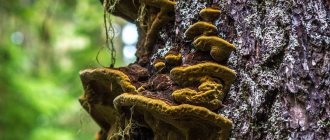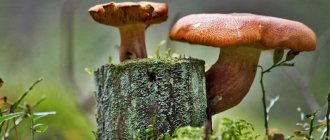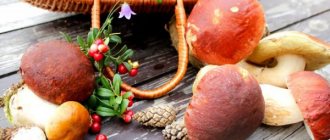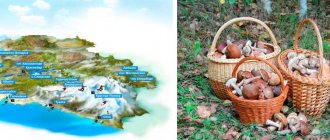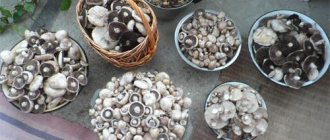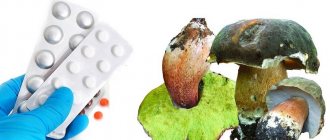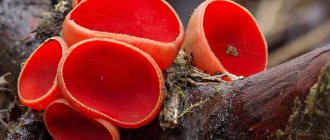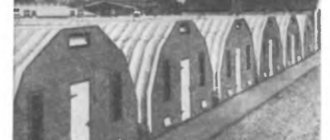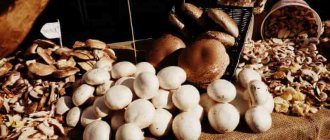Key Features
All tree fungi are parasites.
This is due to the fact that the spores they secrete form mycelium, which destroys the trees and sawdust where they grow. Varieties of tree mushrooms have two characteristic differences:
- The Chinese black mushroom is distinguished by the absence of a pronounced cap and stem. They are represented by a single fruiting body of wavy shape;
- Shiitake mushrooms are similar in appearance to some members of the champignon family.
What tree mushrooms have in common is that they secrete a specific enzyme that breaks down trees, which ensures rapid growth of the mycelium. Due to the unpretentiousness of mushrooms to external conditions, they are actively grown at home and on an industrial scale.
Some tree fungi are considered to be forest health workers, despite their status as parasites. This is due to the fact that many arboreal representatives live on old and weak trees. These mushrooms include honey mushrooms.
The most dangerous parasite is northern Climacodon. This type of tree fungus belongs to the subspecies of tinder fungi. Its danger lies in the fact that it parasitizes the trunks of healthy trees and completely destroys them in just 4 years.
Where and when do they grow?
Muer mushrooms - a delicate secret of oriental cuisine “Dog Ears” grow on very weakened or dead trunks of deciduous trees, most often on alder and elderberry. These mushrooms prefer deciduous forests with high humidity. Found singly or in small groups. Auricularia are widespread in the warm part of the northern temperate zone, found in Eurasia from Western Europe to the Far East, but they are widely known mainly in Asian countries. In Russia, this species can be found in the southern regions, in the Rostov Region, Krasnodar Territory, and the Caucasus.
These mushrooms bear fruit from the end of March until the onset of winter. They are very resistant to light frosts. In Asian countries, thanks to the climate, they bear fruit all year round.
Growing on the trunk
A group of organisms numbering several dozen species parasitizes living and dead wood. It received the common name “woody”. It includes both edible, high nutritional value, and poisonous specimens.
The spores of the parasite are carried by the wind, falling on the bark, they are embedded in microcracks and begin to grow inside the wood. By secreting special enzymes, the mycelium breaks down cellulose and sugars, feeding on them. The fruiting body begins to develop on the surface of the trunk, forming growths of various shapes.
A healthy plant is rarely affected by the parasite. Its victims are old, sick, damaged specimens.
A living culture affected by spores gradually collapses and dies. Having discovered signs of infection on dacha plantings, it is necessary to urgently take measures to clean the bark and disinfect the wood. An unhealthy trunk can cause the death of the entire garden.
Poisonous
It is necessary to know what dangerous specimens look like so as not to confuse them with useful ones. General distinctive features of woody specimens unsuitable for collection:
- cap size is too large;
- the internal structure is rigid, colored red, brownish-brown;
- complete absence of a leg.
It is better not to pick up a questionable copy. Poisonous juice can cause burns, affecting the skin of the hands.
Poisonous species that can be found in domestic forests:
- Ganoderma southern (southern tinder fungus). A parasite that causes white rot of plants. Distributed in deciduous forests (poplar, alder, linden) of northern and central Europe. Has no legs. The growth is semicircular, convex on top, often with sagging, 30-45 cm in diameter. The color is gray, brown, light brown. The inner surface is reddish-brown, woody, without juice, odorless.
- False scent. Common name for several species (gray, sulfur yellow, brick red) unsuitable for collection. Outwardly similar to real honey mushrooms, they grow on rotting wood. The main differences: the absence of a mushroom smell and “skirt” on the stem, the slimy surface of the head in damp weather conditions.
Ganoderma southern (southern tinder fungus)
False honey agaric
- Galerina bordered. In terms of toxicity, it is on par with the toadstool. Outwardly it resembles a honey fungus (small size of a brownish-brown cap, characteristic scales), but is found in coniferous forests. It smells like flour. Forms groups of 5-7 pieces, often growing singly.
- Askokorine meat. Forms unattractive dirty red bumps on birch stumps. It got its name due to the similarity of the fruiting bodies with pieces of fresh meat. Has no aroma and no nutritional value.
- Kalocera sticky. Rotting stumps and fallen trunks provide shelter for Kalocera. On the surface of the bark, thin “branches” of bright yellow color are formed, directed upward. The structure of the pulp is rubbery.
Galerina bordered
Askokorine meat
Kalocera adhesive
Collecting edible woody organisms is often fraught with difficulties: there are a large number of poisonous species, only young bodies need to be collected. It is safer and more convenient to enrich your diet with a healthy product by growing oyster mushrooms, honey mushrooms, and shiitakes yourself. These species reproduce well on a special substrate consisting of sawdust, straw, packed in a bag. By growing forest products with your own hands, you can be confident in the safety of the product.
Types of tree mushrooms
In order to figure out which ones can be collected in the forest and which ones cannot, we will consider separately the types of edible and inedible xylotrophs.
Edible
Edible tree mushrooms quickly gained wide popularity, because they grow in huge families, and they can be found almost anywhere in Russia.
Oyster mushroom is one of the most beloved species, because they are quite easy to grow in artificial conditions, but this will not affect their taste and aroma in any way. Oyster mushrooms grow in large families, on trees both living and dead. The hat is matte, and the leg is long. Color ranges from pale gray or beige to orange.
Muer is considered a delicacy and is widely appreciated in China, Thailand, Japan and Vietnam. The xylotroph grows only on living trees, usually alder. Although it is popular mainly abroad, it can also be found in eastern Russia. The black tree mushroom has a specific appearance, colored dark brown, sometimes black.
Honey fungus is another popular type of edible xylotroph that can be found in Russia, and even grown at home. The taste and appearance of honey mushrooms have been familiar to everyone since childhood. As a rule, several processes grow from one base at once, each of which has its own stem and cap.
Shiitake (imperial) - very similar to a regular champignon: it has a brownish cap, and its stem is fibrous. The xylotroph itself is very fleshy and has a slightly pungent taste. In China it is used not only as food, but also as medicine.
The tinder fungus is sulfur-yellow. Despite the fact that the wood tinder fungus does not look like an edible one, it can be eaten. It grows on weakened trees and looks like a yellow, slightly velvety growth. The pulp of the tree mushroom itself is very tender and juicy. If it is quite old, it may taste a little sour.
Inedible
This variety, as a rule, has a very unattractive appearance and it is unlikely that anyone would think of collecting it. These xylotrophs can be distinguished only by a description of their appearance, for example:
- coral or sponge - Kalocera;
- resin – Ferrous Exidia;
- polyurethane foam – Dacrimitses;
- meat pieces or minced meat - Meat Askokorine.
Kalocera - breeds on rotten wood, can reproduce throughout the summer. It has a bright color: from yellow to orange. It covers the entire territory in which it grows, after which no other plants will be able to grow on the tree.
Glandular Exidia - belongs to the “Tremors” family, can change its shape depending on the climatic conditions in which it grows. The xylotroph pulp is jelly-like and can completely envelop the trunk and branches of the tree.
Dacrimitses is very rare and is considered one of the smallest species. It grows in the form of fibers or droplets of bright orange color. Grows actively in damp conditions and loves moisture. If the weather becomes dry, the villi fold, hide in the bark and become flat.
Meat Askocorine is one of the most unpleasant looking xylotrophs. The shape and color resembles fresh meat. Quite often it can be found on birch trees or stumps, usually already rotten. Most often found in Europe and North America.
Edible
Among tree parasites, only a small part of the species is suitable for food use. But even they are preferably collected young; old fruiting bodies can cause digestive upset.
The harvested crop can be fried, after boiling, pickled, dried, or frozen.
Oyster mushroom
A lamellar growth that parasitizes a deciduous tree. Well known to gourmets for its delicate structure and exquisite taste. It is grown industrially, slightly inferior in popularity to champignons.
Related article:
Where do truffles grow?
In nature it is found on living and dead trunks, mainly in temperate climates. Begins to form in early summer, harvesting ends in autumn. Oyster mushrooms form in clusters of 4-30 caps, often high above the ground.
Appearance:
- the head is dense, smooth, round with a downward curved edge, 7-25 cm in diameter;
- color cream, gray-ash, milky brown;
- plates sparse, white in young specimens;
- the leg is short;
- The pulp is white, odorless.
Among the varieties of oyster mushrooms you can find the pink wood mushroom. The younger the fruiting body, the more intense the color. The pink variety is grown artificially to produce a nutritious product.
Oyster mushroom is considered a valuable food product. It contains organic acids that are important for the human body, statins, saturated fats, and carbohydrates. Oyster mushroom protein is almost completely absorbed after heat treatment.
The benefits and harms of tree mushrooms
You should not think that if a tree fungus is considered harmful, then it cannot contain anything useful. They cause harm only because they suck out all the energy and nutritional properties from healthy plants and concentrate them in themselves.
In this regard, a large number of xylotrophs are nutritious for humans.
It has long been scientifically proven that the xylotrophs that we eat contain a large amount of useful substances, for example:
- protein;
- B vitamins, especially B3;
- vitamins of group C;
- iron;
- calcium;
- phosphorus.
Most vegetarians eat them, thereby restoring the required daily protein intake in the body.
The benefits of tree mushrooms don’t end there. Some also contain other beneficial properties and can be used for pharmaceutical purposes: shaga, tinder fungus, shiitake. Such xylotrophs help:
- high blood pressure;
- normalize iron levels in the blood;
- increase immunity;
- reduce high levels of acidity in the stomach and so on.
Meaning and Application
Most often, tree mushrooms are used in cooking, medicine, and cosmetology.
A large number of xylotrophs, especially in China, are used in cooking and added to dishes. For example, coral is often added to sauces, which gives them a piquant taste.
Some species are used to create cosmetics, for example, lentian is obtained from shiitake. Lentian is a component that is used in almost all Japanese cosmetics.
If shiitake was grown on special wood, then this gives it medicinal properties, since shiitake contains a polysaccharide. Ointments, tinctures and dry healing powders are made from xylotrophs.
To summarize, it is worth saying that tree fungi can cause not only harm to wood and destroy young trees. These xylotrophs have many more beneficial properties, because they help not only make a dish tastier, but also make it healthier.
Features of growing mushrooms on stumps
The types of mushrooms that grow on stumps can be grown at home, creating conditions for them that are as close to natural as possible. The best option is to grow tree mushrooms in your summer cottage.
For stumps, you need to use sections of wood from deciduous trees, or use real stumps left over from recently cut down trees.
Most often, oyster mushrooms are grown on the site. To ensure their growth and normal development, you need to take poplar, birch, and maple wood. Coniferous species should not be used, as they contain a large amount of caustic resins that can destroy the mycelium.
If fresh wood is used, there is no need to soak or moisten it first. If the stumps are old, then they need to be kept in a container with cold water for several days.
After the logs are ready, you can add the mycelium of the selected type of tree fungus. To do this, you can make holes in the hemp in a checkerboard pattern. Their depth should not be more than 6 cm, and their diameter should not be 1 cm.
Mycelium should be poured into these holes. After this, they need to be covered with moss or closed with adhesive tape.
Logs with mycelium must be placed in the basement. They should be folded into a pyramid shape and covered with burlap.
The stumps should remain indoors until the mycelium germinates. After this they can be placed in the ground. It is recommended to do this in May, when normal temperatures have established.
To plant stumps, you should choose a shaded place. You need to dig a hole no more than 15 cm deep, line the bottom with wet leaves or sawdust. You need to place a stump in the hole. The distance between each of them should be at least 35 cm. The stumps should be watered if necessary.
Another way is to grow tree mushrooms in a trench. You can do it this way:
- Dig a trench up to 15 cm deep.
- Pour dry pearl barley onto the bottom, which will provide the mycelium with good nutrition.
- Place disinfected mycelium on top. Each stump should contain 300 g of seed.
- Place the moistened stumps on the mycelium and lightly sprinkle with soil.
After planting tree mushrooms, you need to water the soil. This must be done carefully, since excess moisture does not benefit the growing mushrooms. It is best to use a spray bottle for watering. Watering should be done during dry periods.
For the winter, the mushroom plantation should be covered with a layer of straw or foliage. It is necessary to cover the stumps with material so that the mushrooms do not freeze.
The first harvest, if everything was done correctly, can be harvested within a month after planting the mycelium.
Criteria for distinguishing edible from inedible tree mushrooms
Poisonous mushrooms are most often found on trees. The differences lie in a number of criteria:
- Large hat. Many poisonous mushrooms have a large cap surface diameter;
- The flesh is colored. Most often, if the wood fungus has red or orange flesh, it is inedible.
- Complete or partial absence of a leg. Many poisonous mushrooms are represented either by only a cap or an extremely small stalk.
These universal criteria will help you choose an edible mushroom. However, if there is even the slightest doubt about the identity of the tree mushroom, you need to throw it away.
What mushrooms are used to treat?
There are tree mushrooms that have healing properties. They are used to make various medicines.
| Russian variant | Latin name | External description | Medicinal properties | Place of growth | Photo |
| Varnished tinder fungus (Lingzhi or Reishi mushroom) | Ganoderma lucidum | The mushroom is shaped like a kidney or an egg. The upper surface is smooth, shiny, painted in various dark colors. The pulp has an ocher structure without aroma or taste. | Medicines made from this plant have an antitumor effect and strengthen the immune system. Used to improve metabolic processes in the body, blood circulation, normalizes blood pressure, helps with loss of strength | Habitat: stumps and wood of dried deciduous trees | |
| Larch sponge (agaricus) | Fomitopsis officinalis | It has a fruiting body of gray-whitish, pale yellow or white color, and has an oblong-cylindrical shape, but may look like a hoof. Weight up to 10 kg | Has a laxative effect, soothes, stops bleeding. Used as a mild sleeping pill, reduces sweating | They grow on conifers, prefer larch | |
| The tinder fungus is beveled | Inonotus obliquus | It can reach 6-40 cm in diameter. It looks like a growth with an irregular shape. The surface is black, strewn with many small cracks | Used as an antigastritis and antitumor agent. Has a diuretic and antispasmodic effect | Likes to settle on birch trees, can be found on alder, elm, rowan |
The effect of fungi on trees
All fungi growing on trees are parasites and have a negative effect on the condition of the tree. As a result of such relationships, trees die. If plants in the garden are affected, they must be disposed of immediately. Some gardeners believe that it is enough to cut out the affected branch and get rid of dry branches that have already died. But this is not enough, because fungal spores quickly spread and end up under the bark of trees. They can also be carried by the wind from one plant to another. Spores ripen in most species by early autumn. Damaged and dead branches must be destroyed before this time. Otherwise, the spores, once on the bark, form a mycelium from which mushrooms will grow. But not necessarily in the same year. The mycelium sometimes develops inside the trunk for 2-4 years.
The interaction between the affected tree and healthy plants should be minimized. Cut branches are burned. If you want to grow edible polypores or honey mushrooms, then it is better to grow them on stumps.
The exception is species growing nearby tree crops. During their growth, the root system of the tree is entwined with hyphae. It doesn't harm him. It shares carbon nutrition with the fungi, and in return receives water and minerals, which are well absorbed from the soil by hyphae. This type of relationship is called mycorrhiza. For them, plant residues are also a good source of food for another group of fungi - saprophytes.
Distribution area
Shiitake is a saprotrophic plant that grows only on dead or fallen trees. Wood is a source of nutrients necessary for maturation and reproduction. Has an interesting appearance.
Southeast Asia (China, Japan, Korea and other countries), Russia, Primorsky Krai and the Far East are the main distribution areas of this species. He prefers stumps, fallen trunks, Mongolian oak and Amur linden, chestnut, birch, maple, poplar, liquidambar, hornbeam, ironwood, mulberry and many others. The appearance occurs in autumn, and the fruiting period occurs throughout the summer and ends at the end of autumn.
Shiitake grows at an extremely fast pace. First, tiny caps appear, which fully ripen after 7-9 days. Thus, the specimen has a number of unique features. It is an educational object of study for specialists.
Some useful tips
In cooking they are used in such dishes as:
- Fish dishes (in the form of dry seasoning).
- Meat dishes (especially beef, chicken and pork).
- Soups (boiled).
- Side dishes.
When storing mushrooms, you need to remember that when dried they last for quite a long time, but when wet they last only a couple of days. To store dry mushrooms you need a dry and cool place.
When choosing mushrooms, you should pay attention to the specks. For example, if there are greenish or white tints, this most likely indicates old, stale mushrooms. Dried mushrooms, which initially seem small, swell in water and become several times larger than before.
A box of store-bought dried mushrooms can absorb up to five liters of water. Some experimenters argue that the water needs to be changed periodically, along with the temperature, ranging from ice to boiling water.
Proper brewing of mushrooms is characterized by the fact that it takes quite a lot of time, as it requires good heat treatment. This mushroom needs to be cooked for at least two hours. Even frying is best done after prolonged processing. This is because the mushroom itself is not poisonous, but its environment can affect its quality.
Mushroom stems are usually not used in the dish, but they can be added to the soup, finely chopped, for flavor. Mushrooms have a bland taste, but if you use it in dishes, it tends to take on the tastes and smells of other dishes, turning into something individual and unique. In the form of chips, they have a bitterish-sour taste.
Sources
- https://ECOportal.info/treevesnye-griby/
- https://ofazende.ru/kakie-griby-rastut-na-derevyah
- https://lesoteka.com/derevya/drevesnye-griby
- https://gribnik.info/drevesnye-griby/
- https://FermoVed.ru/gribyi/kotorye-rastut-na-derevyah.html
- https://gribysobiraem.info/vidy-drevesnyh-gribov/
- https://MrDachnik.com/drevesnye-griby
- https://ferma.expert/griby/griby-na-derevyah-i-pnyah/
- https://polzaivredno.ru/drevesnye-griby-polza-i-vred/
How are they useful?
Mushrooms, as a rule, are supplied in dried form - this makes them more convenient to transport and store. When dried, they do not lose vitamins and microelements, but they must be soaked before use. The benefits of tree mushrooms in dried and fresh form are as follows. They contain calcium, iron, vitamin D, chitin, potassium, polysaccharide, phosphorus, acids, and protein.
Tree mushrooms do not contain calories and are considered dietary products. They are indispensable in diets, as they help cleanse the intestines and give a feeling of fullness. So, for example, tinder has twenty-four kilocalories, and shiitake has a little more - thirty-four.
The benefits of tree mushrooms in the human diet are that they have a beneficial effect on:
- gastrointestinal tract;
- reduction of cholesterol and sugar levels;
- stable functioning of the heart and blood vessels;
- brain function, help improve concentration and memory;
- musculoskeletal system;
- liver, protecting it from toxins.
Experts confirm that mushrooms are beneficial for radiation exposure, preventing cancer and treating diabetes. Even their benefits for smokers have been proven - coral tree mushroom contains nicotinic acid. In turn, muer prevents vitamin deficiency. Shiitake fruits are good for the respiratory system, and in Chinese teaching they are regulators of positive Qi energy.
Spring mushrooms photo
As soon as warm days set in after a long winter, one is drawn to nature to breathe the forest air, enjoy the first rays of the sun, and admire the awakening of nature. The first scatterings of trees, green grass emerging through last year’s leaves, and if you’re lucky, even the first snowdrop mushrooms can be seen in the forest waking up from winter hibernation.
The lines first appear in the clearings of the pine forest already in April.
Morels are another representative of the earliest spring mushrooms.
A cute family of oyster mushrooms can be found on trunks and stumps in the spring forest.
Japanese and Chinese mushrooms: shiitake, reishi, meitake, cordyceps chinensis
Eastern medicine has been using the medicinal properties of mushrooms for several millennia. There is a well-known treatise by the healer Wu Rui, written in the 14th century, which describes several dozen types of beneficial mushrooms and methods of using them.
Shiitake was actively studied by medical institutes in Europe and Asian countries; based on the research results, patents were obtained for the use of drugs based on these tree fungi for the treatment of heart and vascular diseases, to combat cancer, and for the treatment and prevention of viral infections. Shiitake is also used for diabetes and as a powerful immunostimulant.
Reishi is called the “mushroom of immortality.” In Chinese and Japanese medicine it is used to treat allergies, cardiovascular diseases, and cancer.
Meitake is included in remedies for gynecological diseases. This mushroom helps fight the symptoms of menopause and normalizes the functioning of the hormonal system. Effectively reduces weight and is used in the fight against obesity.
Cordyceps chinensis is a strong adaptogen. Medicines based on cordyceps have an anti-inflammatory effect, help remove toxins, improve the functioning of the liver, lungs, hematopoietic system and blood supply.
Winter honey fungus Flammulina Velutipes
A mushroom from the genus Flammulina, family Physalacriaceae, also known as Flammulina Velvety-footed and Winter Mushroom.
Appearance
The cap is up to 10 cm in diameter, first hemispherical, then prostrate, yellow-brown in color with a darker middle. In damp weather the cap becomes slimy.
The hymenophore is lamellar, sparse, sometimes with additional shortened blades, cream-colored, darkening with age. Spore powder is white.
The leg is up to 8 cm long and up to 0.8 cm in diameter, hard and cylindrical, the same color as the cap, but darker in the lower part.
The pulp is thin, whitish-yellow, with a pleasant taste and smell.
Growing conditions
It grows from September to spring, often emerging from under the snow during a thaw. Fruits especially abundantly in October and November. Excellent frost tolerance. Inhabits deciduous trees, especially poplars and willows, most often in clumps and dense groups. Loves forest edges and river banks.
Culinary use
A good edible mushroom, which is recommended to be boiled for 20 minutes before eating.
This mushroom received cult status in Asian cuisine, where its artificial variety was bred - enokitake, which is completely different in appearance from its wild counterpart, and most of all resembles long white nails.
What edible mushrooms appear in the summer at the beginning and end of June: photos, list, names
Experienced mushroom pickers are looking forward to the June mushroom season. This is an amazing opportunity to stock up on your favorite gifts of nature without waiting for the abundant autumn harvest.
It is in this summer month, if there is appropriate weather with fog and rain, that the first surge of the mushroom layer occurs.
Appears:
- Common boletus
Suillus luteus
- Sulfur-yellow tinder fungus (conditionally edible)
Laetiporus sulphureus
- boletus
Leccinum
- Boletus
Redhead
- Green moss mushrooms
Xerocomus subtomentosus
- Wood-loving collibia
Collybia dryophila
Continues to grow abundantly:
- Meadow honey fungus
Lamellar type of mushrooms
- Champignon
Agaricus
- Occasionally there are pigs
Paxillus involutus
By the end of the month the following begin to appear:
- Firstborn foxes
Cantharellus cibarius
- Valui
Russula foetens
- Russula
Russula
- Loadings
Russula
- White mushrooms
Birch bearweed, Boletus edulis
- The main mushroom backbone in June is the summer honey fungus
Kuehneromyces mutabilis
The earliest edible mushrooms in spring: names, list
In non-black earth conditions, the very first mushrooms appear in April.
The following can survive the last frost and delight you with the first mushroom harvest:
- Morels (lat. Morchella). They form in groups or grow singly: in gardens, parks, forests. Can be found next to aspen, poplar, alder
First mushroom joys
- Skarkoscifa. It looks like a red cup or flower. Due to its unusual appearance, it has many popular names: “elf’s bowl”, “grandmother’s ear”, “scarlet saucer”, “rednushka”, “red petitsa”, “red saucer”. Habitat: mixed forests and park, along the road
Sarcoscypha
- Strobilurus is edible. It has a lamellar structure. Selects spruce and pine forests for fruiting, near pine trees. You can find group and single growths.
Strobilurus esculentus
When to go to the forest to pick mushrooms?
The timing of the appearance of mushrooms cannot be determined by the calendar. Moreover, in different climatic regions they will vary greatly due to the average daily temperature and the level of solar insolation. Everything greatly depends on specific temperature and humidity indicators, so you need to navigate by the weather.
In the south of Russia, in the Krasnodar, partly Stavropol Territory and Rostov Region, the first fruiting bodies appear from the ground at the end of March, if conditions are favorable. Wooded areas gravitating towards Bryansk and the Volga region are filled with mushrooms later - in the second half of April. Well, those who live near the Siberian taiga will have to wait until May - it is too cold in early spring in these places.
For mushrooms to appear, it must be not only warm, but also quite humid, otherwise the mycelium will not release fruiting bodies to the surface. Therefore, if the sun shines for a long time and everything around has dried out, the chances of mushrooms appearing are reduced. In the forest, moisture evaporation is much less, and the soil takes longer to dry, so here the chances of finding mushrooms on sunny days in spring are easier.
